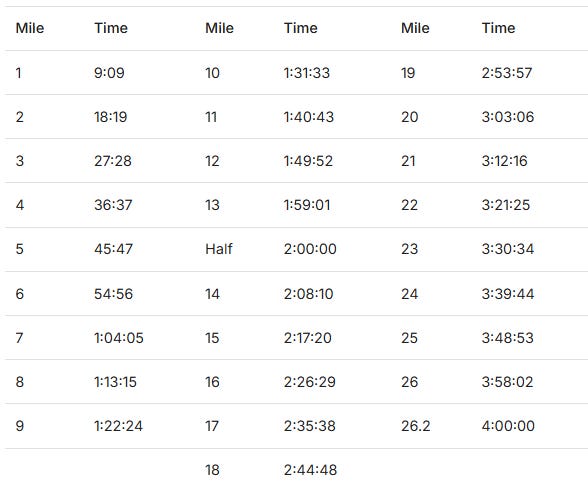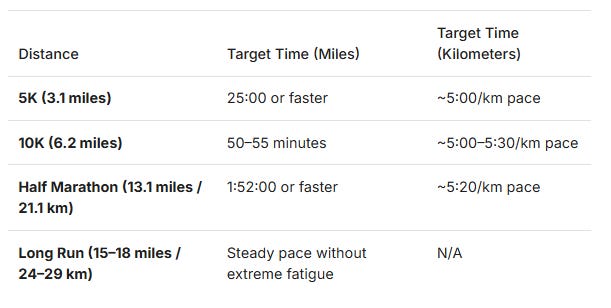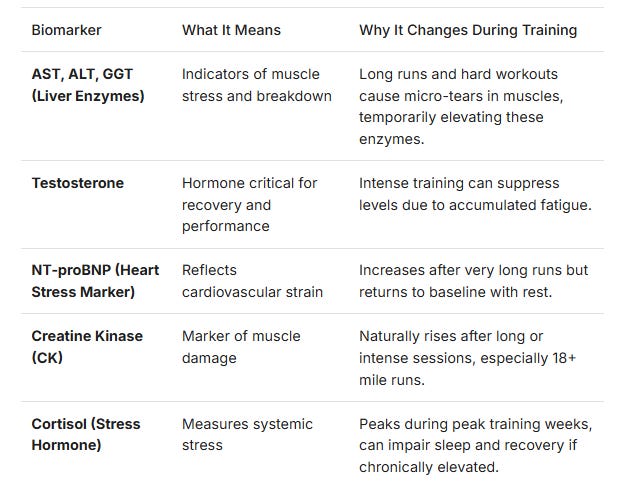Sub 4 Hour Marathon Pace: 16 Week Marathon Training Plan and Tips
To finish a marathon in 4 hours, you need to run at an average pace of 9:09 per mile or 5:41 per kilometer for the entire 26.2 miles (42.195 km). This ensures you cross the finish line under four hours, even with brief slowdowns at aid stations or crowded sections.
When I ran my first marathon, the running clinic predicted a 3:34 finish based on my VO2max of 55 ml/min/kg. They were surprisingly close—I crossed the line in 3:26. But what I learned during that race went far beyond VO2max or raw fitness.
Marathon success comes down to three key factors:
Pacing discipline – holding back early so you have strength left for the final miles.
In-race fueling – providing your body with enough carbohydrates and electrolytes to avoid hitting the dreaded wall.
Avoiding late-race mistakes – staying mentally strong and physically efficient between miles 20 and 26.
Training for a marathon isn’t just about preparing for race day—it’s about building longevity in your running journey. By focusing on sustainable training practices, proper recovery, and smart nutrition, you’ll not only reach your marathon goals but also set yourself up for years of healthy, injury-free running.
What Pace Is a 4 Hour Marathon?
To complete a marathon in exactly 4 hours, you need to maintain 9:09 per mile (5:41 per kilometer) pace. But here’s what I learned the hard way: you need a pacing device, and you need to practice using it.
During my 3:30 marathon, I set my Apple Watch to alert me if I deviated by more than 10 seconds per mile. Even with these alerts, I was often wrong about whether I was going too fast or too slow. Your perceived effort lies to you, especially in the first 10 miles when adrenaline makes everything feel easy.
Target 9:00 per mile (5:35 per kilometer) to build a buffer. You’ll lose time at aid stations, in crowds, and in case your watch dies at mile 23 (yes, this happened to me—charge your watch AND turn off unnecessary features like location sharing).
Sub-4:00 Marathon Pace Chart in Miles and km
To run a 4-hour marathon, you must maintain a steady pace of 9:09 per mile or 5:41 per kilometer throughout the entire race.
Use the following pace charts to track your progress and stay on target during training runs and race day. These splits also help with pacing strategy when using a GPS watch or race wristband.
Marathon Pace Chart - Miles
Start slightly slower in the first 2–3 miles to conserve energy. Aim to negative split by running the second half of the race a few seconds faster per mile.
Marathon Pace Chart - Kilometers
How to Use This Pace Chart
For training runs: Set your GPS watch to alert you if you go faster or slower than 9:09 per mile (or 5:41 per km).
For race day: Write key split times on your wristband or use the pace alerts feature on your running watch.
For pacing groups: Many marathons have official 4-hour pace groups—use this chart to stay aligned with their target splits.
How Fast Is A 4 Hour Marathon?
A marathon covers 26.2 miles or 42.195 kilometers. At 4 hours, you’re running 25% longer than I’d ever run in training—and that final 25% is where most runners fall apart.
Using Riegel’s Formula (New time = old time × (new distance / old distance) ^ 1.06), I tracked my projected marathon time throughout training. When I ran 10 miles in 71 minutes, that predicted a 3:17 marathon. The formula was remarkably accurate—I finished in 3:26.
For 4-hour marathoners, if you can run:
10 miles in 89 minutes, you’re on track
Half marathon in 1:52, you’re ready
20 miles in 3:03, you’ve got the endurance
Who Can Run a 4:00 Marathon?
Based on my experience analyzing marathon data and training approaches:
Runners who can commit 3 days per week: The FIRST “Less is More” program I followed used just 3 runs weekly—perfect for avoiding injury while building fitness
Those with a 50-55 minute 10K: This indicates you have work to do but the goal is achievable
Athletes willing to practice race nutrition: You cannot wing this on race day
Runners who track data: You need objective pace feedback, not feelings
People who can follow a marathon exercise plan: Marathon success is about consistency, not heroic workouts
If you’re not yet at these benchmarks, spend a training cycle improving speed and endurance before attempting a sub-4 marathon goal.
The Reality of Marathon Fueling (What Actually Matters)
Your fueling strategy can make or break your marathon. Many runners who “hit the wall” in the final 10K simply ran out of glycogen — the stored carbohydrate your body uses for energy.
To finish strong and avoid late-race fatigue, you need to replace carbs steadily throughout the race, along with proper hydration and electrolyte balance.
Here’s what changed my marathon: ignoring carb-loading and focusing entirely on in-race fueling.
A 2013 Copenhagen Marathon study found runners consuming 60+ grams of carbohydrates per hour ran 5% faster than those eating freely1.Critically, ALL of the benefit came in the final quarter of the marathon. The “freely eating” group averaged 38g per hour and still bonked—they needed 70% more carbs.
Meanwhile, a cycling study found that in-race carbohydrate intake improved performance by 9%, regardless of whether breakfast was consumed2. Translation: forget the pasta dinner—focus on race-day fueling.
For a 4-hour marathon:
Required: 60g carbs per hour minimum (240g total)
Method: 10-12 gels, starting at 45 minutes, then every 30 minutes
I tested different gel brands during training—Maurten, GU, and Honey Stinger. Yes, Maurten is pricey, but find what your stomach tolerates. The worst place to discover you can’t handle a gel is mile 18.
Creating a 4 hour Marathon Training Program That Actually Works
After analyzing training studies, I found that polarized training—combining high-volume slow runs with high-intensity work—produced the best endurance improvements3.
But here’s what most plans miss: the brutal reality of long runs. A tempo run leaves you tired but functional. A 20-mile long run leaves you destroyed. My post-run walking pace would drop to half-speed. Plan your long run days accordingly—you’re not doing anything else that afternoon.
The Three Runs That Matter
1. Long Slow Distance (LSD): Start at 10 miles, build to 20. These aren’t about speed at all—they’re about time on feet and pacing practice. Run them at whatever pace you can hold comfortably for the entire duration. During early LSD runs, set your watch to notify you of pace every kilometer or mile—this helps develop a feel for consistent rhythm. For the second half of each long run, practice negative splitting by speeding up 10-20 seconds per mile. This teaches the discipline you’ll need when every fiber wants to start fast on race day.
2. Tempo/Threshold Runs: 4-6 miles at 8:30-8:45 pace. These hurt but teach your body to clear lactate. I struggled to hit these paces initially but could outrun them after 4 weeks.
3. HIIT/Speed Work: Since I’d been doing high intensity interval training for years, I kept my regular 30-minute sessions rather than traditional track work. This maintained my VO2max gains without additional impact stress.
The Sauna Secret
My VO2max increased from 55 to 61.5 ml/min/kg during training—placing me in the 99.7th percentile. The secret? Post-exercise sauna sessions increase VO2max gains by over 40%4.
During training, I hit the sauna 4 times weekly instead of my usual 3. That’s 16 extra hours over 16 weeks. No sauna? Hot baths provide similar benefits.
Sample 16 Week Marathon Training Plan (What I’d Do Differently)
A 4-hour marathon is achievable with a structured 16-week program focused on progressive mileage, balanced workouts, and proper recovery.
This plan is designed for runners who:
Can currently run 15–20 miles (24–32 km) per week comfortably.
Have a base long run of 6–8 miles (10–13 km).
Can train 3–4 days per week consistently.
Goal: Finish in 3:59 or faster by averaging 9:09 per mile (5:41 per km) on race day.
Knowing what I know now, here’s the 3-run-per-week plan I’d follow for a 4-hour marathon:
Weeks 1-4: Base Building
3 runs weekly: 1 LSD (10-14 miles), 1 tempo (4 miles), 1 HIIT
Weekly mileage: 20-25
Practice with pace alerts on every run
Weeks 5-8: Endurance Focus
LSD: 14-18 miles, focus entirely on holding steady pace without checking watch constantly
Practice negative splitting: increase pace by 10-20 seconds/mile after halfway point
Practice race nutrition every long run—same gels, same timing, same hydration
Weekly mileage: 25-30
Weeks 9-12: Peak Training
LSD: 18-20 miles
Primary focus: can you hold the same pace for 20 miles that you held for 10?
Negative split practice: deliberately run first half slower, then gradually increase pace
Tempo runs extend to 6 miles
Weekly mileage: 30-35
Weeks 13-16: Taper
Maintain intensity, cut volume by 40%
Final 20-miler two weeks out
Practice race-morning routine
Test watch battery on longer runs!
Race Day Reality Check
Race day is where months of training come together — or fall apart.
The key to success is sticking to your plan, resisting the urge to start too fast, and staying mentally strong when fatigue sets in.
The First 10 Miles: The Lying Zone
Your body will lie to you. You’ll feel amazing. You’ll want to run 8:30 miles. Don’t. Set your watch to beep if you go faster than 9:00 pace. When it beeps, slow down immediately—don’t negotiate with yourself.
Why this works: Starting too fast burns glycogen early, leading to “the wall” at mile 20.
Even pacing or slight negative splits lead to faster overall times.
Miles 11-20: The Fueling Window
This is where you win or lose your race. If you’re not taking gels every 30 minutes, you’re setting up for disaster. I noticed nausea creeping in midway through my marathon, but it disappeared right after eating a gel. Nausea often signals low blood sugar, not overeating.
Miles 21-26.2: The Truth
My watch died at mile 23. I had no idea of my pace, time, or remaining distance except for occasional course markers. I slowed 5% but still finished on target.
Lesson: Prepare for technology failure. Know what 9:00 pace feels like without a watch.
Common Failure Points (And How to Avoid Them)
Even the best training plan can be ruined by avoidable mistakes.
These are the most common errors runners make before and during a marathon — and how you can prevent them to secure your sub-4-hour finish.
1. Starting Too Fast: Adrenaline and excitement at the start line lead to early glycogen burn
Solution: Run 9:00 pace from the start—even those first 3 miles when you feel invincible. Use pace alerts. Ignore everyone passing you—you’ll see them again at mile 22.
2. Inadequate Fueling: Many runners hit the wall simply because they don’t take in enough carbohydrates during the race
Solution: Set a timer for every 30 minutes. Take a gel whether you feel like it or not. The Copenhagen study proved this works.
3. No Pacing Discipline: Running by “feel” often leads to pace fluctuations and wasted energy
Solution: Practice running by pace, not by feel. Use a watch with pace alerts. Set it to beep if you’re more than 10 seconds per mile off target.
4. Untested Gear/Nutrition: Race day is not the time to experiment with new shoes, clothing, or fuel.
Solution: “Nothing new on race day” includes socks, underwear, and breakfast. I tested everything, including eating three pieces of white toast with honey at 5 AM.
5. Watch Battery Death: Technology isn’t foolproof, and a dead watch mid-race can leave you guessing your pace.
Solution: Turn off Bluetooth, location sharing, and music. Use basic pace tracking only. Bring a basic backup watch showing elapsed time.
The Biomarker Reality
During peak training, my blood work showed:
Elevated liver enzymes (AST, ALT, GGT)
Lower testosterone
Higher heart stress markers (NT-proBNP)
Three weeks post-marathon, everything returned to normal. Marathon training is a controlled stress experiment—your body will complain, then adapt, then recover.
These changes are normal and temporary if managed properly with rest, fueling, and gradual mileage progression.
Most biomarkers return to baseline within 2–4 weeks after the marathon, depending on recovery strategies.
If markers stay elevated beyond 4 weeks, consult a healthcare provider to rule out underlying issues.
4 Hour Marathon Pace - Frequently Asked Questions
What Is the Pace for a 4-Hour Marathon
To complete a marathon in under 4 hours, you need to maintain a steady pace of 5:41 per kilometer or 9:09 per mile throughout the full 42.2 km (26.2 miles) distance.
How to Run a Marathon Under 4 Hours
Run 9:09 per mile (5:41 per km), follow a structured plan with long runs, speed work, and race-pace training. Start slightly slower, practice your fueling and hydration in training, and consider running with a 4-hour pacer group for support.
How many days/hours a week should I train?
Stick to 3 quality runs weekly: 1 long, 1 tempo, 1 speed. Total: 4-6 hours. More runs mean more injury risk for minimal benefit. Focus on nailing these three runs rather than adding junk miles.
What weekly mileage do I need?
I averaged 23 miles per week and ran 3:26. For 4:00, aim for 25-30 miles weekly with peaks at 35. Quality matters more than quantity.
Do I really need 60g of carbs per hour?
Yes. The Copenhagen study proved it. Runners are taking less bonk in the final 10K. That’s 10-12 gels for a 4-hour marathon. Test different brands during training to find what works—Maurten, GU, Honey Stinger, even honey packets. Better to spend money on gels than DNF at mile 22.
What if my watch dies?
Run by effort. You should know your marathon pace breathing pattern from training. Have a backup method—even a basic Timex showing elapsed time helps.
Is walk-run viable for sub-4:00?
Yes. Run 9 minutes at 8:50 pace, walk 1 minute = 9:05 average. Jeff Galloway has coached thousands to sub-4:00 with this method.
How accurate is Riegel’s Formula?
Very. It predicted my marathon within 3%. Use it weekly to track fitness: Time = old time × (26.2/distance) ^ 1.06
Should I carb load?
The cycling study showed that in-race fueling matters more than pre-race loading. Eat normally, then nail your race-day nutrition.
What about the wall?
The wall is glycogen depletion. If you take 60g of carbs per hour, you won’t hit it. The Copenhagen runners who fueled properly had no wall—they negative split.
Breaking 4 hours taught me that marathons aren’t about suffering—they’re about preparation. Set your watch, eat your gels, ignore your feelings, and trust your training. The clock doesn’t lie, even when your legs do.









